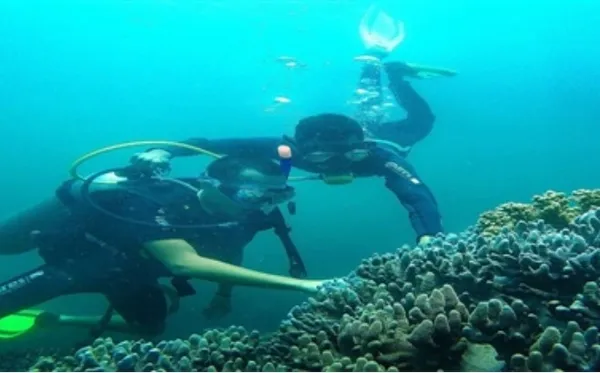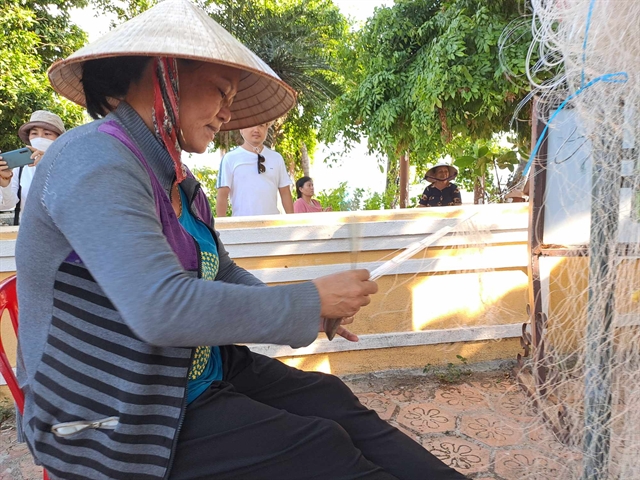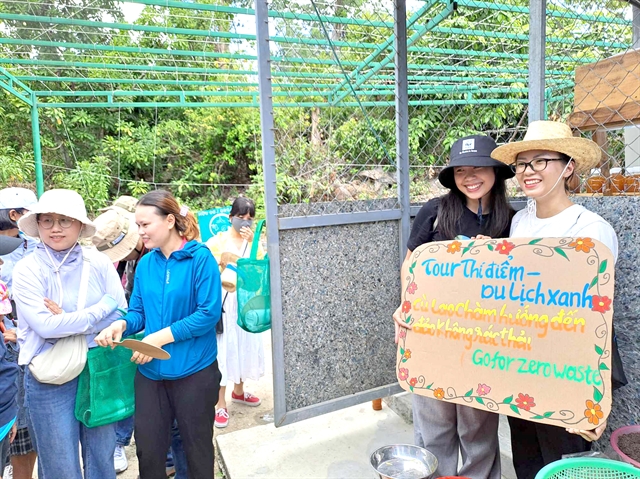 Features
Features

QUẢNG NAM — A community's collaborative marine conservation efforts in recent years have provided sustainable livelihoods for the residents of the Chàm Islands in Quảng Nam Province.
Lying 18km offshore from Hội An Ancient Town, the Chàm Islands (named locally as Cù Lao Chàm) enjoy a rich diversity of estuarine and coastal ecosystems, including seven islets and the main Chàm Island with 2,400 inhabitants.
They have 1,500ha of tropical forests and 6,700ha of waters, home for a wide range of marine fauna and flora.
Recognised as a World Biosphere Reserve since 2009 by UNESCO, the Chàm Islands-Hội An World Biosphere Reserve covers the ancient town of Hội An and the lower area of the Thu Bồn River.
Concerned about the potential extinction of local land crabs, the Management Board of the Cù Lao Chàm Marine Protected Area, together with Hội An authorities, initiated conservation measures in 2006 which also helped create sustainable livelihoods for the island’s residents, the Tài Nguyên & Môi Trường (Natural Resources & Environment) online newspaper reported.
By 2008, these efforts had led to the formation of a community land crab-catching group dedicated to both harvesting and protecting crab populations.
According to Nguyễn Duy Khanh, head of the Cù Lao Chàm land crab cooperative, each hunter is allowed to harvest about 50 land crabs per month, with each crab being at least 7cm wide. Harvesting takes place from January to the end of the seventh lunar month, with a ban during the remaining months to protect the crabs during their breeding season.
Only crabs with a carapace width over 7cm and not carrying eggs, are labelled for market sale, while those that don't meet the criteria are released back into the wild.
Lê Vĩnh Thuận, deputy director of the Cù Lao Chàm Marine Protected Area Management Board, said that the community's work in harvesting and protecting land crabs is a model of how to harmonise conservation and livelihoods within the Cù Lao Chàm Biosphere Reserve.
Recent surveys indicate a gradual increase in the land crab population, contributing to the island’s ecosystem diversity.
Another model is the co-managed marine conservation sub-area in Bãi Hương village, Tân Hiệp Island commune.
Locals are entrusted with over 19 hectares of marine protected area waters, allowing them to manage, control fishing activities and develop services independently.
After a decade in operation, the model is working well.
Initially, livelihoods were unstable, but now fishermen in Bãi Hương have increased their income through fishing and organising tourism tours.
 |
| A local resident weaving a fishing net. — VNS Photo Bùi Hoài Nam |
Following the sub-area's success, residents of Tân Hiệp Island commune continue to grasp technology, assisting the marine protected area in establishing nurseries and restoring over 4000sq.m of hard coral reefs.
This is the first model in the country where the community manages, exploits and develops livelihoods in tandem with the goals of the marine protected area.
Trần Thị Hồng Thúy, deputy head of the Chàm-Hội An World Biosphere Reserve, told Vietnamplus.vn that the site has developed a comprehensive management system.
This system integrates various approaches, including creating an ecosystem, river basin, coast and island management, aiming to preserve and enhance local and globally significant values in line with UNESCO's expectations.
These efforts have established Cù Lao Chàm-Hội An as a trusted and beloved destination for tourists and international visitors, motivating residents and authorities to further beautify Hội An. The city is renowned for its stunning landscapes and rich natural and cultural resources.
A highlight of the reserve site’s environmental protection efforts is the effective implementation of the Hội An City environmental protection plan 2021-2025, with a vision to 2030.
The residents of Chàm Islands have adopted a plastic bag free initiative to reduce single-use plastics citywide.
Conservation projects, educational programmes and awareness campaigns about the biosphere reserve are integrated into the local middle school curriculum.
These initiatives have significantly increased Hội An's appeal to both domestic and international tourists, Thúy said.
Under the pressure of socio-economic development, rapid tourism growth, extreme weather and climate change, there's an increasing threat to various habitats and ecosystems.
Methods and optimal solutions are necessary to conserve natural resources within and beyond the protected area, she said.
Trần Văn Khoa, director of Jack Tran Tours, said that Hội An, including destinations like Cù Lao Chàm, Cẩm Thanh, and Cẩm Kim, has made significant strides in development, particularly in tourism.
The residents living on Cù Lao Chàm have shifted from traditional agriculture and unsustainable fishing practices, to sustainable resource use to move over to income from tourism.
This transition has stabilised and improved residents' quality of life, fostering active participation in conserving the invaluable natural heritage.
A resident of Tân Hiệp island commune, Trần Nhật Sinh, said that the most prominent socio-economic development in Tân Hiệp is its rapid shift from fragmented fisheries to tourism services.
The Marine Protected Area and Biosphere Reserve continuously enhances the lives of island residents, who now recognise that such resources are their lifeline.
Many fishermen who once used explosives and harvested corals and trees illegally have transformed into active collaborators in marine conservation activities.
They now participate in patrolling, controlling fishery and forestry exploitation and engaging in activities such as reforesting, coral transplantation and seabed cleaning, Sinh said.
 |
| Tourists support green travel, saying 'no' to single-use plastic goods on Chàm Islands. — VNS Photo Bùi Hoài Nam |
Quảng Nam's provincial plan for 2021-2030, looking ahead to 2050, designates the Chàm Islands-Hội An Biosphere Reserve as the focal point of a network of coastal wetland reserves.
The government strategy emphasises activities aimed at restoring biodiversity on both a national and international scale. The province aims to translate these efforts into concrete sustainable development initiatives, aligning with global environmental objectives like the UN's Decade on Ecosystem Restoration 2021-2030.
This strategic move not only fulfils Việt Nam's commitments to international biodiversity agreements, but also acts as a catalyst for overall development in Quảng Nam province. — VNS




